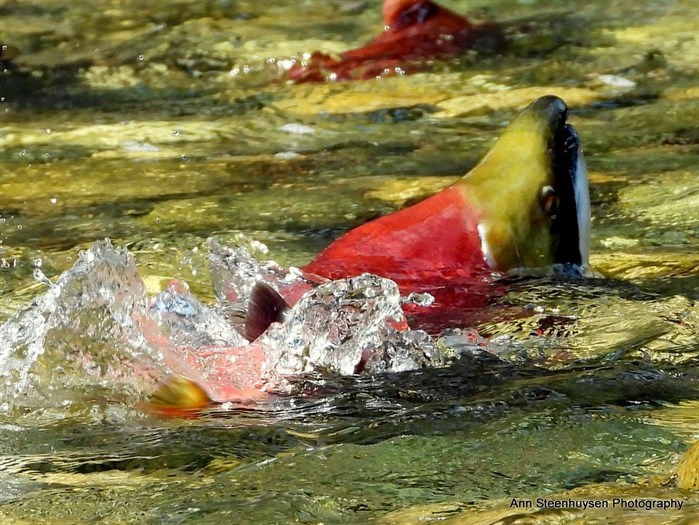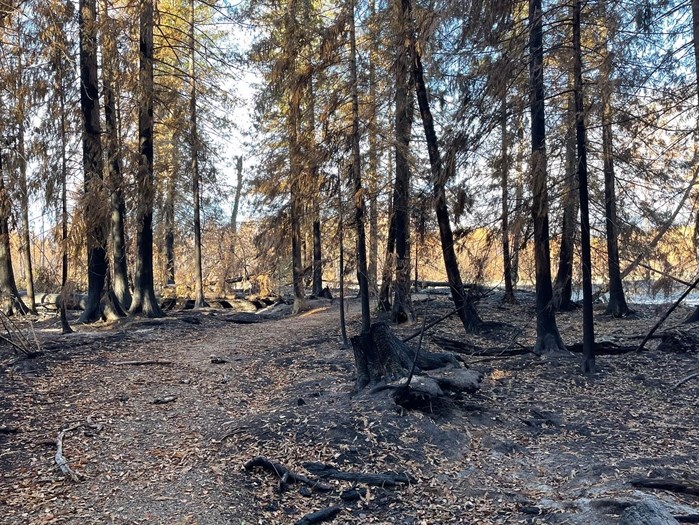
A sockeye salmon makes waves with its tail during a salmon run in Scotch Creek near Salmon Arm.
Image Credit: SUBMITTED/ Ann Steenhuysen
March 17, 2024 - 3:30 PM
Climate change is impacting salmon and the way salmon streams are being cared for in the province.
Intense wildfires, drought conditions and extreme weather events are all playing a part in making the salmons’ migratory routes to spawning grounds in the Interior more perilous.
Jason Hwang is a fish biologist located in Kamloops and vice president of the provincial Pacific Salmon Foundation.
“There are definitely concerns in terms of the effect of fire going through important salmon rivers and watersheds, we do worry about aquatic ecosystems," Hwang said.
While wildfires are a natural part of the ecosystem, he said the fires in recent years are bigger, more intense and more frequent, prompting new approaches to management of fish streams to be considered.
“The effects of wildfire on streams and salmon varies depending the intensity of the fire," Hwang said. "Wildfires are now outside the traditional natural cycle, they're more intense and frequent, so we look at the immediate effects on fish."
The biggest thing to worry about and watch for is how a wildfire that moves across a large part of a watershed changes snowfall and rainfall runoff patterns.
“There’s less absorption by the ground causing higher peak flows and lower low flows, there isn’t a sponge effect,” he said. “The run off can cause significant changes to sediment and debris on smaller scales and larger debris flows like the one in the Cache Creek area that went across the highway.
“If your landscape is severely destabilized and combined with intense rainfall events it can have severe effects in the watershed and aquatic ecosystem.”
Last summer, 80 percent of the Tsutswecw Provincial Park in the Shuswap was damaged by the Bush Creek East wildfire. Known for having one of the largest sockeye salmon runs in North American, the park was created in 1977 to protect the spawning beds of a variety of salmon species.
While Hwang hasn’t been on the ground to see the effect of the wildfire on the Adams River he has seen video footage from helicopters and drones, and heard reports from locals.
“The trees beside the stream and loss of stream-side vegetation is a concern,” he said. “Sometimes the vegetation looks scorched but it survives and comes back in the spring because the root systems are there.”
Trees and vegetation along streams are important for keeping the water temperatures low, holding up the banks and dropping insects and leaves into the river which is important to a healthy ecosystem.
“Losing vegetation can cause erosion with sediment and debris washing in which is bad for the fish,” he said. “If natural recovery isn’t happening in a timely way, we’ll look at places to do restoration and recovery efforts. It’s now time to turn our minds to look at that.”

Tsútswecw Provincial Park in the Shuswap is pictured with fire damage from the Bush Creek East wildfire in 2023.
Image Credit: SUBMITTED/ Facebook/ Adams River Salmon Society
The McDougall Creek wildfire was a high intensity out of control fire that devasted parts of West Kelowna and Kelowna last summer, 2023.
The Pacific Salmon Foundation isn’t as involved in the middle and upper Okanagan because the salmon have not been making it that far up the rivers in recent years. The Okanagan Nation Alliance is working in these areas, releasing salmon into the lake.
“The Okanagan Nation Alliance has been out planting hatchery fry into Okanagan Lake," said fisheries biologist with the Alliance, Elinor McGrath in a previous interview with iNFOnews.ca. “What that results in, usually, is the fry home back to the area that they were released in. If you release them into Mission Creek, most of the adults come back into Mission Creek.”
Hwang said the effects of the wildfire on streams in the Okanagan will be similar to anywhere else and could have negative effects on other fish species like trout and whitefish species.
Drought is a growing concern for salmon, causing lower river and stream levels and exposing areas the fish can’t navigate. While there are some places that are identified as potential danger sites in low flows, there isn’t a fully mapped out system yet.
“There are people in the province working on this, identifying potential problem areas particularly where small streams enter rivers or lakes but it’s happening on a small scale,” Hwang said. “Last year where we saw severe drought conditions over a huge part of the province some areas didn’t have anyone looking at them.”
Last September, Xwísten community members saw thousands of salmon get stuck below a rapids section in the Fraser River Canyon north of Lillooet due to low river levels caused by drought.
Several groups worked together and pooled funding to move thousands of the fish by hand over the impasse. A decades-old fish ladder is at the section to help in years of low river levels, but the levels were so low, the ladder didn’t help.
“All hands were on deck, it was satisfying,” Hwang said. “Every minute hundreds of salmon were throwing themselves on the rocks, not making it. An excavator made a little channel more passable and salmon were swimming under it. It wasn’t perfect but a good number of salmon were getting by. We just had a meeting about it, more work will be done at that site.”

An excavator is seen opening an access channel for pink salmon to leave Kamloops Lake and access spawning grounds up Tranquille Creek.
Image Credit: SUBMITTED/ Facebook/ Pacific Salmon Foundation
During the same time in Kamloops a team of organizations came together to dig an access channel for salmon leaving Kamloops Lake to swim up Tranquille Creek to spawn, another impasse caused by drought and unstable soils.
"We were part of that, the province did a lot of the work and the local ranch helped by releasing water from their storage," Hwang said. "It was a dry ditch but when I went out a few days after the water was flowing the salmon moved in right away, it's one of many success stories.
In the Okanagan, the preliminary counts for salmon for 2023 were low due in part to heat and drought.
“Most of the chinook and sockeye held in the Columbia River in Wells Pool down by Brewster until fairly late in the summer because the temperatures were really high and that’s the main thing that blocks them from moving up,” McGrath with the Okanagan Nation Alliance said.
READ MORE: Farm Credit Canada offering helping hand to hard hit Okanagan fruit and grape growers
The salmon can return to spawning areas in June and July but once the temperature in rivers and lakes hits 22 Celsius they are blocked. When they were finally able to get upriver by the third week of August, they had already suffered some fatalities while waiting to head upstream. They spawn in mid-October. Once in the Okanagan, low or no flows in creeks like Vaseux and Shuttleworth prevented some from spawning.
In response to the climate changes causing intense forest fires the foundation has put a book together on what can be done to mitigate the effects of wildfire and accelerate recovery.
“We know how to control sediment and reduce debris flow, we know who to do habitat restoration and riparian planning, but up until now we haven’t been apart of the traditional post wildfire response,” Hwang said.
READ MORE: Rebuilding from Okanagan wildfires bogged down by insensitive insurance companies
There is hope for the salmon, he said, but we need to work together to make a difference.
“It’s not all bad news, from what I can see from assessment data from last year it could have been the biggest chinook return on record. Other populations had great returns relative to their brood, still below conservation levels, but better," he said.
"If we continue to be good stewards of our resources the salmon have the ability to rebound. We haven’t wrecked things beyond repair. We can look after things and have resilient salmon populations for generations.”
READ MORE: iN VIDEO: Sneak peak of documentary on Shuswap wildfire
While donations to the foundation are always helpful, there is an online reporting tool the public can use to quickly report issues with salmon and salmon streams to the foundation such as areas of low flow.
“We can’t do something if we haven’t heard about it, and we can share reports with our First Nations and government. We need reporting from people out there. Everyone can help by making sure we look after our natural ecosystems.”
The Pacific Salmon Foundation, founded in 1987, is a non-profit environmental organization dedicated to the conservation and restoration of wild Pacific salmon and their habitats in B.C. and the Yukon.
To contact a reporter for this story, email Shannon Ainslie or call 250-819-6089 or email the editor. You can also submit photos, videos or news tips to the newsroom and be entered to win a monthly prize draw.
We welcome your comments and opinions on our stories but play nice. We won't censor or delete comments unless they contain off-topic statements or links, unnecessary vulgarity, false facts, spam or obviously fake profiles. If you have any concerns about what you see in comments, email the editor in the link above. SUBSCRIBE to our awesome newsletter here.
News from © iNFOnews, 2024